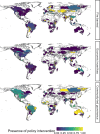A global expert elicitation on present-day human-fire interactions
- PMID: 40241454
- PMCID: PMC12004094
- DOI: 10.1098/rstb.2023.0463
A global expert elicitation on present-day human-fire interactions
Abstract
Human fire use contributes to fire regimes and benefits societies worldwide yet is poorly understood at the global scale. We present the Global Fire Use Survey (GFUS), an effort to elicit and systematize knowledge about fire use from experts, including academics and practitioners. The GFUS data cover the stakeholders using fire, reasons for and seasonality of burning, recent trends in anthropogenic ignitions and burned area and the presence/absence and effectiveness of different policy interventions targeting fire use. The survey garnered 311 responses for regions covering over 50% of the Earth's ice-free land, improving on the coverage of literature syntheses on fire use. Here, we analyse the data on the distribution of fire use and policy interventions. The survey suggests that the most widespread fire users are Indigenous and local people burning to meet objectives associated with small-scale livelihoods and cultural priorities, whereas burning by commercial land users, state agencies and non-governmental organizations is less widespread. Regulatory restrictions are the most common policy interventions targeting fire use but are ineffective in achieving their aims in regions with higher burned area. While community-led governance of burning is rarer, it was deemed more effective than restrictive policy interventions, particularly in regions with higher burned area.This article is part of the theme issue 'Novel fire regimes under climate changes and human influences: impacts, ecosystem responses and feedbacks'.
Keywords: contested knowledges; expert elicitation; fire policies; human fire use; indigenous fire ecologies.
Conflict of interest statement
We declare we have no competing interests.
Figures



References
-
- Smith C, Perkins O, Mistry J. 2022. Global decline in subsistence-oriented and smallholder fire use. Nat Sustain 5, 542–551. (10.1038/s41893-022-00867-y)) - DOI
-
- Fowler CT, Welch J. 2018. Fire otherwise: ethnobiology of burning for a changing world. Salt Lake City, UT: University of Utah Press.
-
- Millington JD, Perkins O, Smith C. 2022. Human fire use and management: a global database of anthropogenic fire impacts for modelling. Fire 5, 87. (10.3390/fire5040087)) - DOI
-
- Pyne SJ. 2021. The pyrocene: how we created an age of fire, and what happens next. Oakland, CA: University of California Press. (10.1525/9780520383593) - DOI
MeSH terms
Grants and funding
LinkOut - more resources
Full Text Sources
Medical

